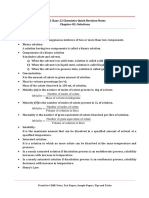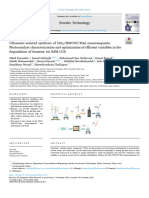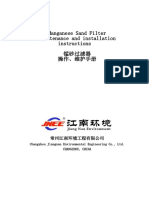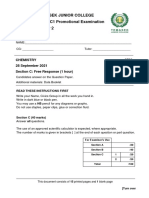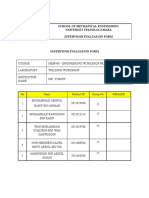van't Hof Factor (
" Relative Lowering of v.p : In terms of molecular weight of solute
M,=
W,x M, MIND MAP-2 Certain solutes which undergo dissociation or association in solutions are found to show
abnormal molecular mass. Thus, in order to know about the extent of association or dissociation
w.P of solutes in solution van't Hoff in I886 introduced a factor (). It is defincd as the ratio of the
normal mass to the observed molecular mass of the solute i.e.
Where, P&P,= vapour pressure of pure solvent and solution Colligative properties
solution depend on the total Normal molar mass
n. n, moles of solute & solvent concentration of all solute particles, regardless of ;since, molecular mass oc
their ionic or molecular nature, charge, or size. Observed molar mass Colligative property
W, W,&& M,. M,= W,. W, are the masses and M,, M, are the -No. of particles
molar masses of the solute and solvent respectively. Observed colligative property .. i= Total number of particles after association dissociation
No ofmolecules (ln the solution of non-electrolyes)
Elevation in b.p. AT, K,m -No of sons (ln the kolution ofelectrolytes) Nornal colligative property No. of particles before association/dissociation
K, boiling point elevation constant or molal clevation The value of i depends upon the state of solute in the solution. Following cases may become
constant (ebulloscopic constant) having unitK kg mol possible.
W, K,W, 1000 when i1. then the solute remains unaffected (ic., normal) in solution.
m molality [m W1000JF aT M, W. when >1. then the solute undergoes dissociation in solution.
AT, -T, T, sOLUTIONS| when, i< I, then the solute undergoes association in solution.
Modificd equation for colligative properties.
T, &T, are the boiling point of solution and pure solvent. n
Depression in L.p. AT,- Km Osmotie Pressure (*) : pe iz, =ntn, AT, K,m: AT, - iK,m: RT
K= freezing point depression constant or molal depression Osmotic pressure is the hydrostatic presst
constant or cryorcople constant. produced when a solution is separated from t
solvent by a semipermeable membrane. Solubility : Maximum amount ofa substance that can be dissolved in a
K,WA
ATM WX l00O AT,- T-T, Osmotic pressure may be defined as the exce specificd amount of solvent at a specified temperature it depends upon
pressure which must be applicd to a solution Nature of solute Nature of solvent Temperature Pressure Raoult's Law
T,& T,are the freezing point of solution and pure solvent. order to prevent flow of tinto the soluti Solubility of a solid in liquid Solubilty of a gas in liquid (P,P +(P-P)
through the semipermeable membrane
The values of K, and K, which depend upon nature of the solvent Effect of nature of solute and Efect of temp. Follow same order P-PÅ+ (P,+P,x, where P,
can be determined from the following relations. Osmotic pressure (n) RT CRT
solvent like dissolves like as in case of solid. Total
M,RT M,RT For dilute solutions, osmotic pressure is found t Effect of temp = Exothermic Effect of pressure Henry's law states pressure. PÅ & P = vapour
1000AH 1000 A, H follow the equation (n) = v RT= CRT process increase with rise in that the partial pressure of the gas in pressure in pure state of two
vapour phase (p) is proportional to the constituents A and B in solution
Here, R & M, stand for the gas constant and molar mass of solvent (CGay-Lussac-van't Hoff law) temp.
mole fraction of the gas (x) in the
Endothermic process
in g mol.T,&T, freezing point and the boiling point. AH& when w gof solute are dissolved in V litre of decrease with risc in temp. solution"pht
AH- enthalpies for the fusion and vaporisation of thesolvent. solutions and M is the molar mass of the solute. Effect of pressure No effeet K Henry's law constant solubility
respectively. then wRT W
(n) V n M Types of solution
Concentration of solutions
Mass of solute
Noe-ideal solutions
Classiflcation based on physical state: Mass percentage (wW) Total mass of solution-x 100
Ideal solutlon Positive deviation from Raoult's law Negative deviation rom Raoult's law Gas in gas (Air) No, of moles of solute
Gas in liquid (Soda water) "Molarity (M)
() Obcy Raoult's aw at every range ) Do not obey Raoult's law Do not obey Raoult's Iaw. Volume of solution (L)
Gas in solid (Hydrogen in Pd)
0, total volume of olution () AV, 0. Volune is increaned afler ) AV.<0. Volume is decreased during Liquid in gas (Fog) No, of moles of solute
is oqual to the sum of volumes of dissolution dissolution, "Molality (m)
the components
Liquid in liquid (Aleohol in water) Weight ofthe solvent in kg
(mj s H ;neither heat is cvolved . SLiquid
olt sold (Amalgams)
( ) AH 0. Endothermic dissolution, ) AH, 0, Exothernic disolution, hcat No. of grams equivalent of solute
din gas (Smog) "Normality (N)
(iv) AC d
attrastson are less than (iv)A
Volume of solution (L )
iv) of attraction are greater than
Interactions present in the fwo A Aand B Battractive forces, A AAandBBattractine forces Aand B Solid in liquid (Sugar in water) No, of mnoles of solute
liguids should be same, ie., A and B have different shape, size also have different shape, sre and Solid in solid (Alloys) . Mole fraction (N)Total moles in solution
and Bare identical in shape, size ) p, PAA: Ph Pa character
(va Pcharacter.
-PaPAAPa PAS PAA:Pa <Paa Volume of solute
"Volume percentage (vV) Total volume of solution
100
Le.P,p,P- P' (vi) Escaping tendency of Aand Bis : PePAA Paa Classifieation based on
(vi) Escaping tendency of Aand Bis very high (showing higher vapour (iV) Due to lower escaping tendency it shows concentratlon No, of parts of solute
same in pure liquids as well as in pressure than expected) lower vapour pressure than expected *Ppm -x 10
the solution Example
Dilute solutions Total no. of parts of all components of solution
Examples Concentrated solutions mass ofsolute
Examples Acctone + Ethanol Acetone + Aniline .Mass by volume percentage ( w l 100
Dilute solutions Ca, -CHCI, Chlorofom +Dietthyl ether Saturated solutions kene of solution (mt.)
Ethyl bromide Ethyl iodide Supersaturated solutions Mass %. ppm, mole fraction and molality are independent of
n-Butyl chloride n-Butyl bromidke























